
Employer Plan API | Administrative - SOAP
The Employer Plan Service provides employer plan functionalities such as reading, adding, updating, and deleting employers’ plan information.
Service Web Methods
The following is a list of methods that is provided by the Employer Plan Service.
AddEmployerPlan – Used to add an employer’s plan information.
DeleteEmployerPlan – Used to remove an employer’s plan.
UpdateEmployerPlan – Used to update an employer’s plan.
GetEmployerPlan – Used to retrieve an employer’s plan.
GetEmployerPlans – Used to retrieve all employers’ plans.
SetPlanPriority – Used to set plan priority for all plans associated with an employer.
GetPlanPriority – Used to get a list of plans in priority order.
Service Assumptions/Business Rules
The Employer Plan Service makes the following assumptions as well as enforce the following business rules.
Clients shall conform to the WS-I specifications unless otherwise agreed upon by Alegeus Technologies and the administrator.
Clients shall format SOAP messages in a Document/Literal format over HTTPS.
Clients shall have already created a valid user ID and password.
Clients shall have a valid session ID after being authenticated by the system. The session ID needs to be passed in the proper manner as described in the Account Manager Service Guide.
If the administrator uses the same user ID and password for all of their clients, the administrator is responsible for managing the security of the data.
Clients should validate data before submitting a request to this Service. This facilitates better performance and accurate processing on both systems.
Clients shall not attempt to use this service for batch processing of large amounts of data. The service is designed for synchronous calls that send or retrieve small chunks of data. If batch processing is required, then the EDI process should be used.
If any method fails, the service returns a SOAP fault describing the problem.
Employer Plan Service is meant to be used only by non-split plan administrator.
AddEmployerPlan
This method is used to add an employer’s plan information.
History
The AddEmployerPlan methods are listed below:
Request Messages
AddEmployerPlan_2023_03
AddEmployerPlan_2021_11
AddEmployerPlan_2021_02
AddEmployerPlan_2020_02
AddEmployerPlan_2019_10
AddEmployerPlan_2019_03
AddEmployerPlan_2018_02
AddEmployerPlan_2012_10
AddEmployerPlan_2012_06
AddEmployerPlan_2011_04
AddEmployerPlan_2010_10
AddEmployerPlan_2010_04
AddEmployerPlan_2009_04
AddEmployerPlan_2008_07
AddEmployerPlan_2007_12
AddEmployerPlan_2006_05
AddEmployerPlan
Response Messages
AddEmployerPlanResponse
AddEmployerPlan Request/Response Messages
The AddEmployerPlan method requires the following request and response messages (input and output data).
The table below includes the following request messages:
AddEmployerPlan_2023_03
AddEmployerPlan_2021_11
AddEmployerPlan_2021_02
AddEmployerPlan_2020_02
AddEmployerPlan_2019_06
AddEmployerPlan_2019_03
AddEmployerPlan_2018_02
AddEmployerPlan_2012_10
AddEmployerPlan_2012_06
AddEmployerPlan_2011_04
AddEmployerPlan_2010_10
AddEmployerPlan_2010_04
AddEmployerPlan_2009_04
AddEmployerPlan_2008_07
AddEmployerPlan_2007_12
AddEmployerPlan_2006_05
AddEmployerPlanRequest
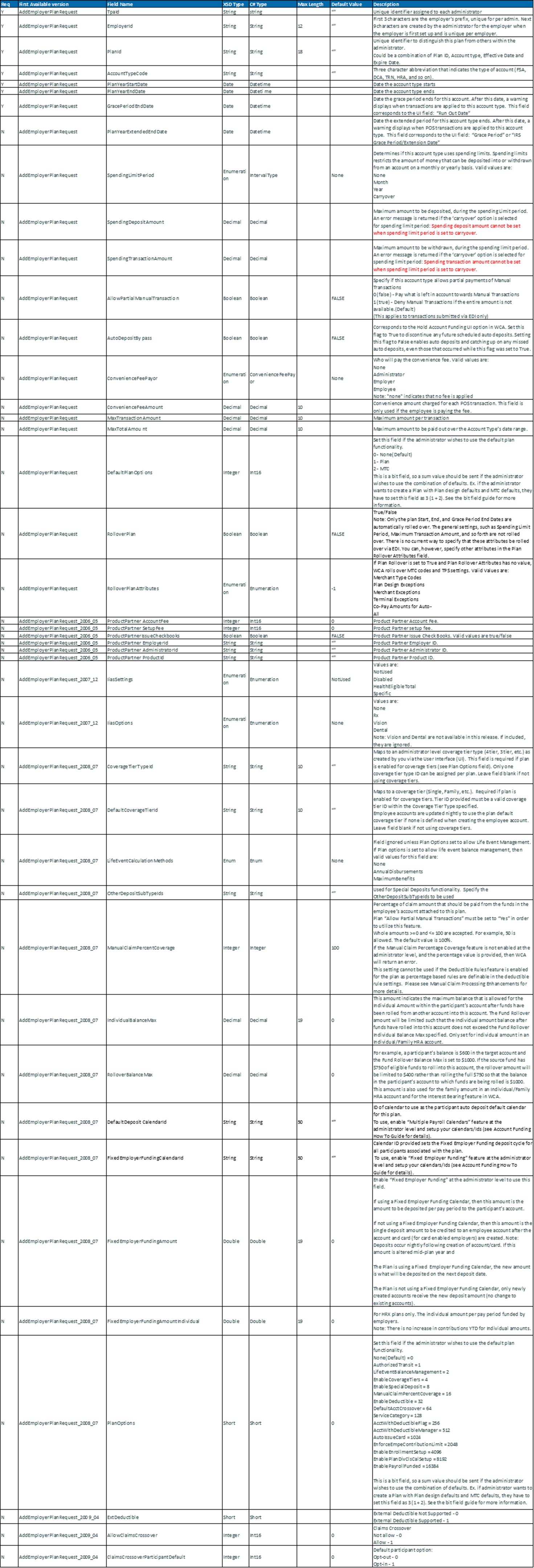
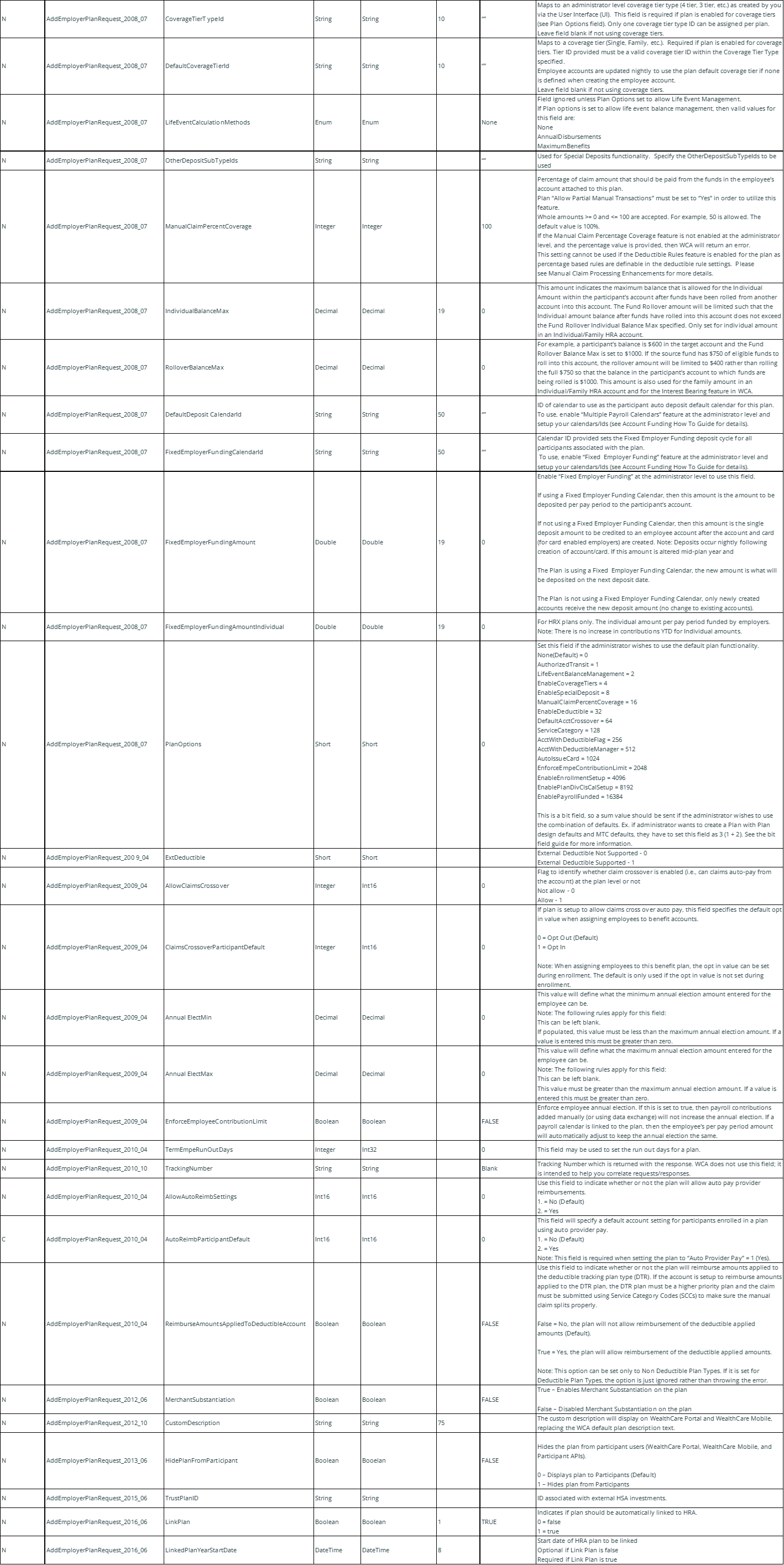
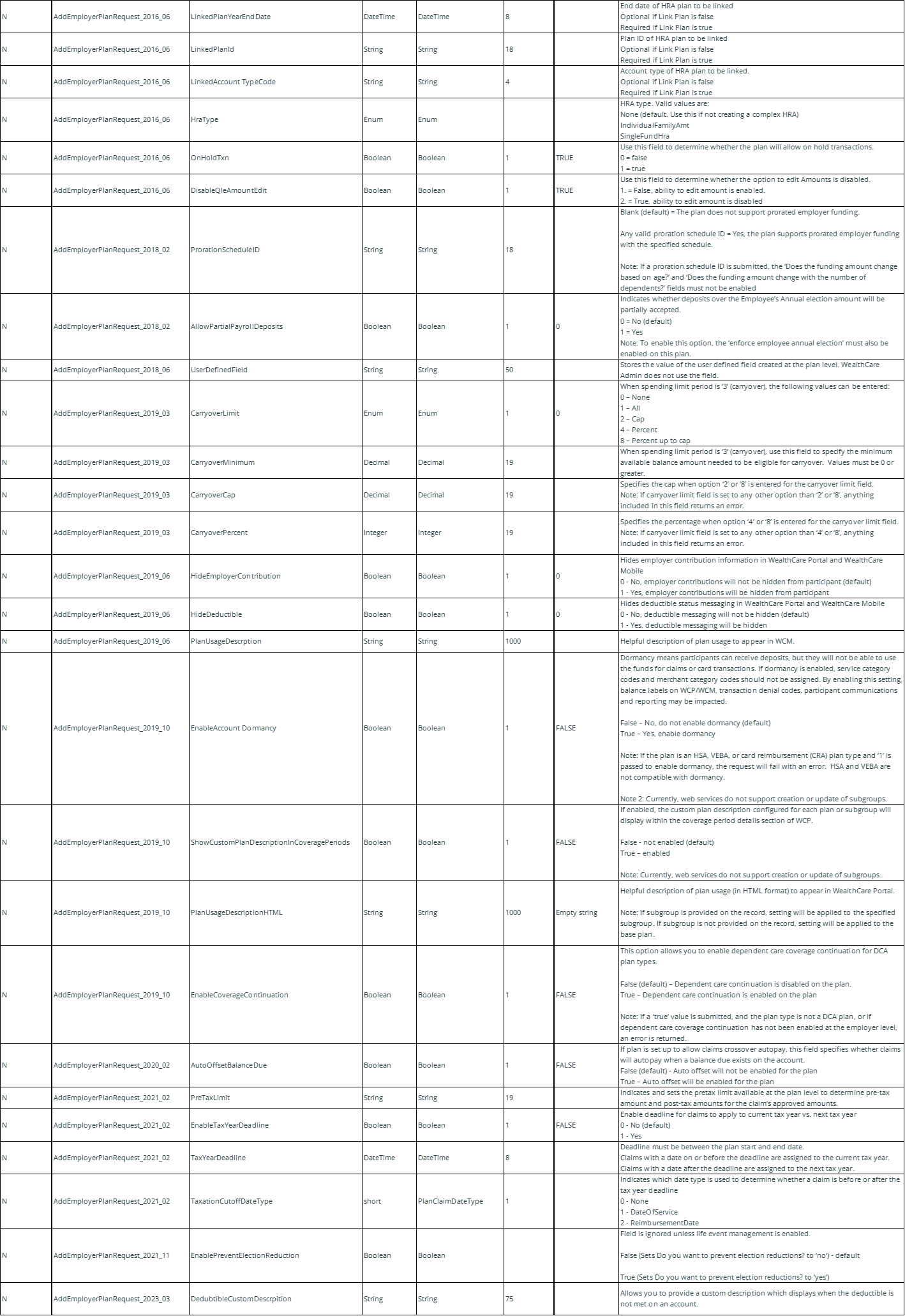
Response Message: Empty Message
Example of an AddEmployerPlan SOAP request message
<?xml version="1.0" encoding="utf-8" ?>
<soap:Envelope xmlns:soap="http://schemas.xmlsoap.org/soap/envelope/" xmlns:xsi="http://www.w3.org/2001/XMLSchema-instance" xmlns:xsd="http://www.w3.org/2001/XMLSchema">
<soap:Header>
<MBISessionHeader xmlns="http://www.medibank.com/MBIWebServices/SoapHeader/">
<MBISessionID>kkhhjnze5fuaxz45fkwama55</MBISessionID>
</MBISessionHeader>
</soap:Header>
<soap:Body>
<GetEmployerBankAccount
xmlns="http://www.medibank.com/MBIWebServices/Employer/Messages/EmployerPlan/Request/2006/05/">
<addEmployerPlanRequest_2006_05>
<TpaId>T00202</TpaId>
<EmployerId>CYNCYN</EmployerId>
<PlanId>CYNP2</PlanId>
<AccountTypeCode>ACO</AccountTypeCode>
<PlanYearStartDate>2004-01-01</PlanYearStartDate>
<PlanYearEndDate>2004-12-31</PlanYearEndDate>
<GracePeriodEndDate>2004-12-31</GracePeriodEndDate>
<SpendingLimitPeriod xmlns="http://www.medibank.com/MBIWebServices/Enums/">None</SpendingLimitPeriod>
<SpendingDepositAmount>0</SpendingDepositAmount>
<SpendingTransactionAmount>0</SpendingTransactionAmount>
<PayCycleTypeCode xmlns="http://www.medibank.com/MBIWebServices/Enums/">NoAutoDeposit</PayCycleTypeCode>
<ConvenienceFeePayor xmlns="http://www.medibank.com/MBIWebServices/Enums/">None</ConvenienceFeePayor>
<ConvenienceFeeAmount>0</ConvenienceFeeAmount>
<MaxTransactionAmount>0</MaxTransactionAmount>
<MaxTotalAmount>0</MaxTotalAmount>
<DefaultPlanOptions xmlns="http://www.medibank.com/MBIWebServices/Enums/">None</DefaultPlanOptions>
</addEmployerPlanRequest_2006_05>
</GetEmployerBankAccount>
</soap:Body>
</soap:Envelope>
Example of an AddEmployerPlan SOAP response message
<?xml version="1.0" encoding="utf-8" ?>
<soap:Envelope xmlns:soap="http://schemas.xmlsoap.org/soap/envelope/"
xmlns:xsi="http://www.w3.org/2001/XMLSchema-instance"
xmlns:xsd="http://www.w3.org/2001/XMLSchema">
<soap:Header>
<MBIMessageIdHeader xmlns="http://www.medibank.com/MBIWebServices/SoapHeader/" />
</soap:Header>
<soap:Body>
<AddEmployerPlanResponse xmlns="http://www.medibank.com/MBIWebServices/Employer/Messages/EmployerPlan/Response/2004/06/">
<AddEmployerPlanResult />
</AddEmployerPlanResponse>
</soap:Body>
</soap:Envelope>
Example Client Code
The following is an example of the client code (using a .NET proxy class for accessing the service) used when calling the AddEmployerPlan web method.
try
{
// Create the session SOAP header in order to pass the Service
// the client’s current session id.
mbiSessionHeader = new EmployerPlanServiceNameSpace.MBISessionHeader();
// Create proxy object for the service
proxy = new EmployerPlanServiceNameSpace.EmployerPlanService();
// Create request message for method call (input parameters)
request = new EmployerPlanServiceNameSpace.AddEmployerPlanRequest_2006_05();
// Set the input parameters
request.AccountTypeCode = _AccountTypeCode.Text;
request.AllowPartialManualTransaction = Convert.ToBoolean(_AllowPartialManualTransaction.Text);
request.AutoDepositBypass = Convert.ToBoolean(_AutoDepositBypass.Text);
request.ConvenienceFeeAmount = Convert.ToDecimal(_ConvenienceFeeAmount.Text);
request.ConvenienceFeePayor =
(EmployerPlanServiceNameSpace.ConvenienceFeePayor)Enum.Parse(typeof(EmployerPlanServiceNameSpace.ConvenienceFeePayor),_ConvenienceFeePayor.Text,true);
request.DefaultPlanOptions = (EmployerPlanServiceNameSpace.DefaultPlanOptions)Enum.Parse(typeof(EmployerPlanServiceNameSpace.DefaultPlanOptions),_DefaultPlanOptions.Text);
request.EmployerId = _EmployerId.Text;
if(_GracePeriodEndDate.Text.Length > 0)
{
request.GracePeriodEndDate = Convert.ToDateTime(_GracePeriodEndDate.Text);
}
request.MaxTotalAmount = Convert.ToDecimal(_MaxTotalAmount.Text);
request.MaxTransactionAmount = Convert.ToDecimal(_MaxTransactionAmount.Text);
request.PayCycleTypeCode = (EmployerPlanServiceNameSpace.PayCycleType)Enum.Parse(typeof(EmployerPlanServiceNameSpace.PayCycleType),_PayCycleTypeCode.Text,true);
request.PlanId = _PlanId.Text;
if(_PlanYearStartDate.Text.Length > 0)
{
request.PlanYearStartDate = Convert.ToDateTime(_PlanYearStartDate.Text);
}
if(_PlanYearEndDate.Text.Length > 0)
{
request.PlanYearEndDate = Convert.ToDateTime(_PlanYearEndDate.Text);
}
request.SpendingDepositAmount = Convert.ToDecimal(_SpendingDepositAmount.Text);
request.SpendingLimitPeriod = (EmployerPlanServiceNameSpace.IntervalType)Enum.Parse(typeof(EmployerPlanServiceNameSpace.IntervalType),_SpendingLimitPeriod.Text,true);
request.SpendingTransactionAmount = Convert.ToDecimal(_SpendingTransactionAmount.Text);
request.TpaId = _TpaId.Text;
// session ID returned from login method
mbiSessionHeader.MBISessionID = _sessionId.Text;
proxy.MBISessionHeaderValue = mbiSessionHeader;
// Call the method
response = proxy.AddEmployerPlan(request);
MessageBox.Show("Finished.");
}
catch(SoapException se)
{
// perform needed operations
}
catch(Exception ex)
{
// perform needed operations
}
UpdateEmployerPlan
This method is used to update information about an employer’s plan.
History
The UpdateEmployerPlan methods are listed below:
Request Messages:
UpdateEmployerPlan_2023_03
UpdateEmployerPlan_2021_11
UpdateEmployerPlan_2021_02
UpdateEmployerPlan_2020_02
UpdateEmployerPlan_2019_10
UpdateEmployerPlan_2019_03
UpdateEmployerPlan_2012_10
UpdateEmployerPlan_2012_06
UpdateEmployerPlan_2011_04
UpdateEmployerPlan_2010_10
UpdateEmployerPlan_2010_04
UpdateEmployerPlan_2009_04
UpdateEmployerPlan_2008_07
UpdateEmployerPlan_2007_12
UpdateEmployerPlan_2006_05
UpdateEmployerPlanRequest
Response Messages:
UpdateEmployerPlanResponse
UpdateEmployerPlan Request/Response Messages
The UpdateEmployerPlan method requires the following request and response messages (input and output data).
The table below includes the following request messages:
UpdateEmployerPlan_2023_03
UpdateEmployerPlan_2021_11
UpdateEmployerPlan_2021_02
UpdateEmployerPlan_2019_10
UpdateEmployerPlan_2019_06
UpdateEmployerPlan_2019_03
UpdateEmployerPlan_2012_10
UpdateEmployerPlan_2012_06
UpdateEmployerPlan_2011_04
UpdateEmployerPlan_2009_04
UpdateEmployerPlan_2008_07
UpdateEmployerPlan_2007_12
UpdateEmployerPlanRequest_2006_05
UpdateEmployerPlanRequest
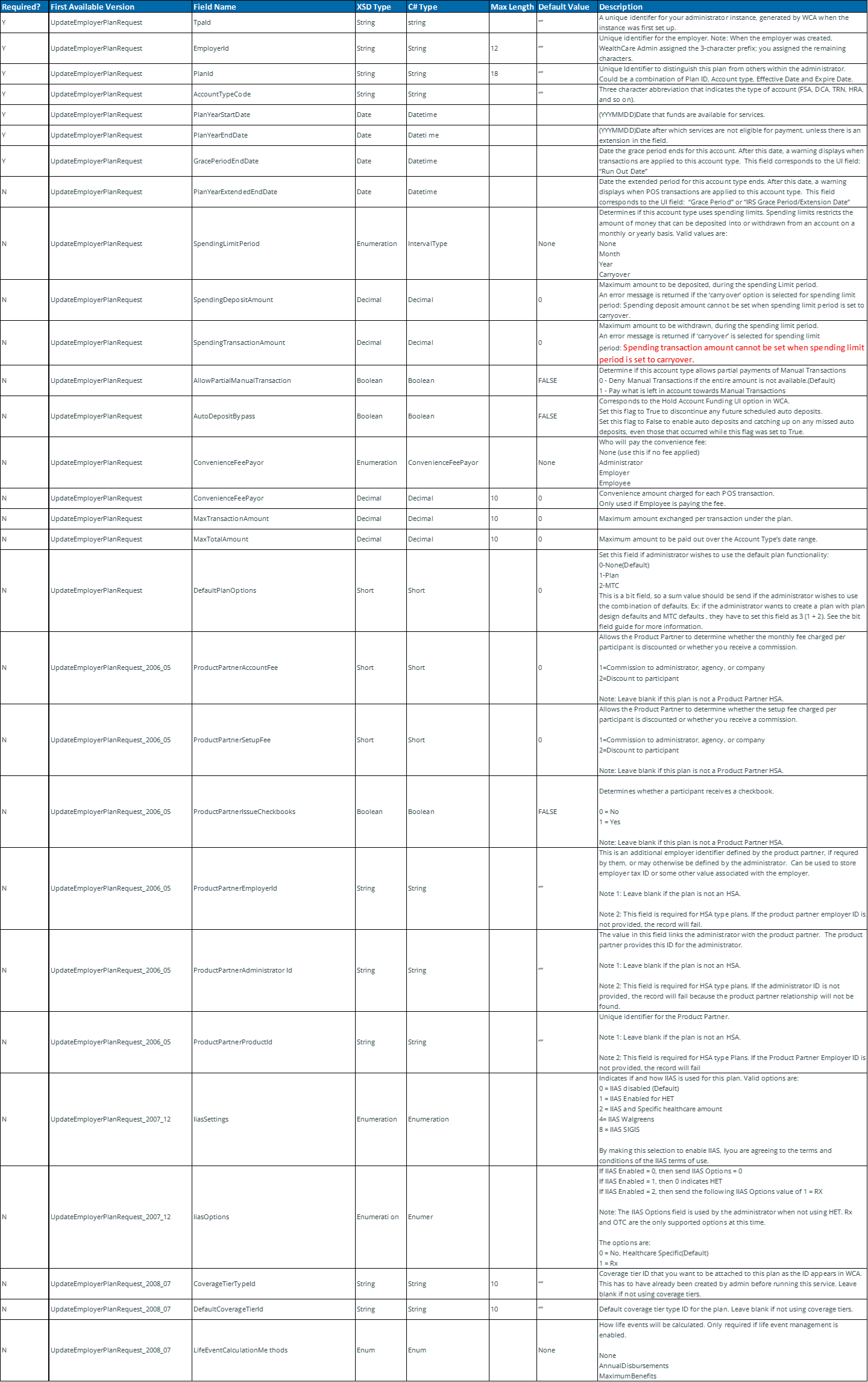

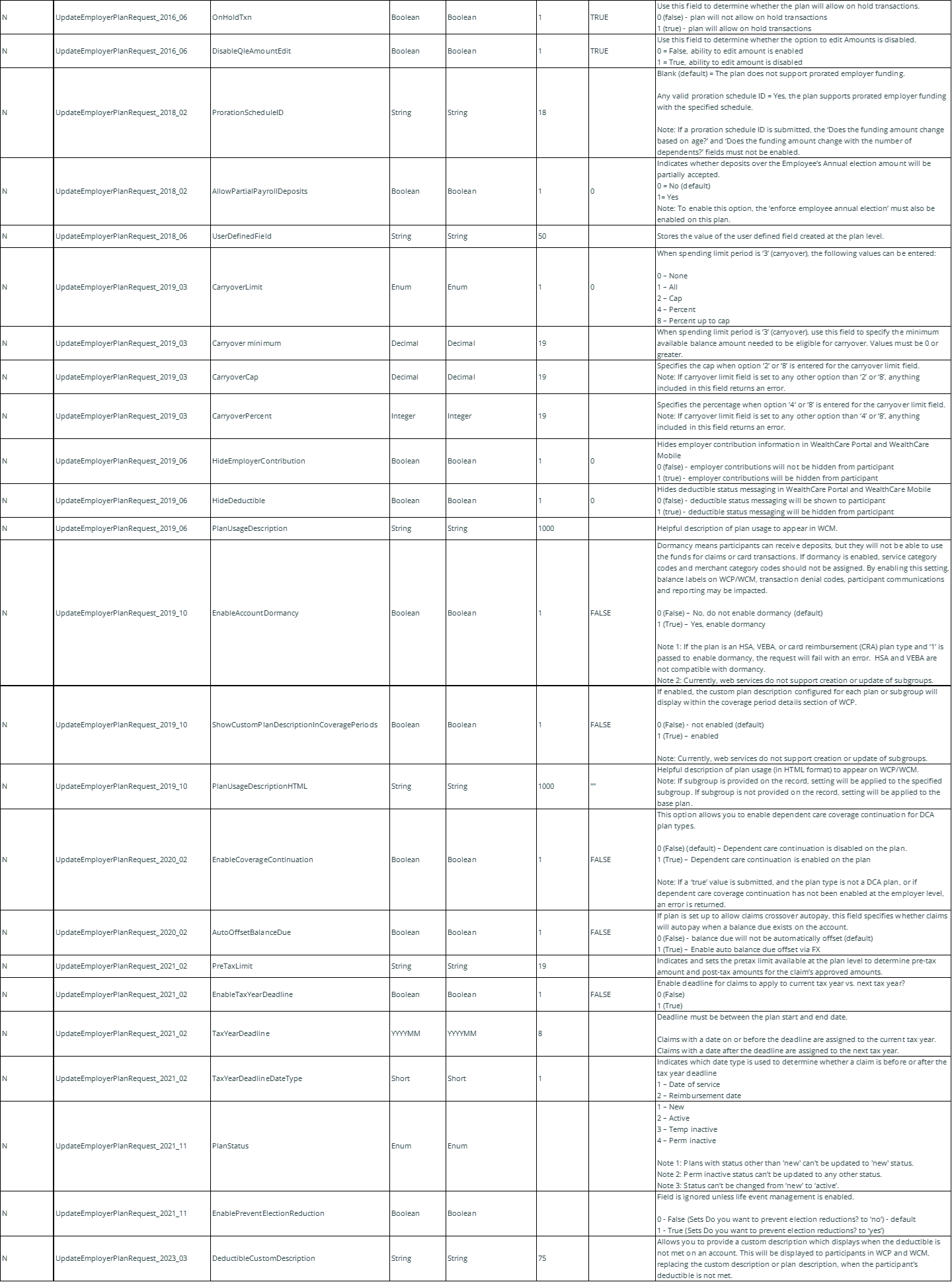
Response Message: Empty Message
Example of an UpdateEmployerPlan SOAP request message
<?xml version="1.0" encoding="utf-8" ?>
<soap:Envelope xmlns:soap="http://schemas.xmlsoap.org/soap/envelope/" xmlns:xsi="http://www.w3.org/2001/XMLSchema-instance" xmlns:xsd="http://www.w3.org/2001/XMLSchema">
<soap:Header>
<MBISessionHeader xmlns="http://www.medibank.com/MBIWebServices/SoapHeader/">
<MBISessionID>kkhhjnze5fuaxz45fkwama55</MBISessionID>
</MBISessionHeader>
</soap:Header>
<soap:Body>
<UpdateEmployerPlan_2006_05
xmlns="http://www.medibank.com/MBIWebServices/Employer/Messages/EmployerPlan/Request/2006/05/">
<updateEmployerPlanRequest_2006_05>
<TpaId>T00202</TpaId>
<EmployerId>CYNCYN</EmployerId>
<PlanId>CYNP1</PlanId>
<AccountTypeCode>ACO</AccountTypeCode>
<PlanYearStartDate>2004-01-01</PlanYearStartDate>
<PlanYearEndDate>2004-12-31</PlanYearEndDate>
<GracePeriodEndDate>2004-12-31</GracePeriodEndDate>
<SpendingLimitPeriod xmlns="http://www.medibank.com/MBIWebServices/Enums/">None</SpendingLimitPeriod>
<SpendingDepositAmount>-1.0000</SpendingDepositAmount>
<SpendingTransactionAmount>-1.0000</SpendingTransactionAmount>
<PayCycleTypeCode xmlns="http://www.medibank.com/MBIWebServices/Enums/">NoAutoDeposit</PayCycleTypeCode>
<ConvenienceFeePayor xmlns="http://www.medibank.com/MBIWebServices/Enums/">None</ConvenienceFeePayor>
<ConvenienceFeeAmount>0</ConvenienceFeeAmount>
<MaxTransactionAmount>100.0000</MaxTransactionAmount>
<MaxTotalAmount>100.0000</MaxTotalAmount>
<DefaultPlanOptions xmlns="http://www.medibank.com/MBIWebServices/Enums/">None</DefaultPlanOptions>
</updateEmployerPlanRequest_2006_05>
</UpdateEmployerPlan_2006_05>
</soap:Body>
</soap:Envelope>
Example of an UpdateEmployerPlan SOAP response message
<?xml version="1.0" encoding="utf-8" ?>
<soap:Envelope xmlns:soap="http://schemas.xmlsoap.org/soap/envelope/" xmlns:xsi="http://www.w3.org/2001/XMLSchema-instance" xmlns:xsd="http://www.w3.org/2001/XMLSchema">
<soap:Header>
<MBIMessageIdHeader xmlns="http://www.medibank.com/MBIWebServices/SoapHeader/" />
</soap:Header>
<soap:Body>
<UpdateEmployerPlanResponse xmlns="http://www.medibank.com/MBIWebServices/Employer/Messages/EmployerPlan/Response/2004/06/">
<UpdateEmployerPlanResult />
</UpdateEmployerPlanResponse>
</soap:Body>
</soap:Envelope>
Example Client Code
The following is an example of the client code (using a .NET proxy class for accessing the service) used when calling the UpdateEmployerPlan web method.
try
{
// Create the session SOAP header in order to pass the Service
// the client’s current session id.
mbiSessionHeader = new EmployerPlanServiceNameSpace.MBISessionHeader();
// Create proxy object for the service
proxy = new EmployerPlanServiceNameSpace.EmployerPlanService();
// Create request message for method call (input parameters)
request = new EmployerPlanServiceNameSpace.UpdateEmployerPlanRequest_2006_05();
// Set the input parameters
request.AccountTypeCode = _AccountTypeCode.Text;
request.AllowPartialManualTransaction = Convert.ToBoolean(_AllowPartialManualTransaction.Text);
request.AutoDepositBypass = Convert.ToBoolean(_AutoDepositBypass.Text);
request.ConvenienceFeeAmount = Convert.ToDecimal(_ConvenienceFeeAmount.Text);
request.ConvenienceFeePayor = (EmployerPlanServiceNameSpace.ConvenienceFeePayor)Enum.Parse(typeof(EmployerPlanServiceNameSpace.ConvenienceFeePayor),_ConvenienceFeePayor.Text,true);
request.DefaultPlanOptions = (EmployerPlanServiceNameSpace.DefaultPlanOptions)Enum.Parse(typeof(EmployerPlanServiceNameSpace.DefaultPlanOptions),_DefaultPlanOptions.Text);
request.EmployerId = _EmployerId.Text;
if(_GracePeriodEndDate.Text.Length > 0)
{
request.GracePeriodEndDate = Convert.ToDateTime(_GracePeriodEndDate.Text);
}
request.MaxTotalAmount = Convert.ToDecimal(_MaxTotalAmount.Text);
request.MaxTransactionAmount = Convert.ToDecimal(_MaxTransactionAmount.Text);
request.PayCycleTypeCode = (EmployerPlanServiceNameSpace.PayCycleType)Enum.Parse(typeof(EmployerPlanServiceNameSpace.PayCycleType),_PayCycleTypeCode.Text,true);
request.PlanId = _PlanId.Text;
if(_PlanYearEndDate.Text.Length > 0)
{
request.PlanYearEndDate = Convert.ToDateTime(_PlanYearEndDate.Text);
}
if(_PlanYearStartDate.Text.Length > 0)
{
request.PlanYearStartDate = Convert.ToDateTime(_PlanYearStartDate.Text);
}
request.SpendingDepositAmount = Convert.ToDecimal(_SpendingDepositAmount.Text);
request.SpendingLimitPeriod = (EmployerPlanServiceNameSpace.IntervalType)Enum.Parse(typeof(EmployerPlanServiceNameSpace.IntervalType),_SpendingLimitPeriod.Text,true);
request.SpendingTransactionAmount = Convert.ToDecimal(_SpendingTransactionAmount.Text);
request.TpaId = _TpaId.Text;
// session ID returned from login method
mbiSessionHeader.MBISessionID = _sessionId.Text;
proxy.MBISessionHeaderValue = mbiSessionHeader;
// Call the method
response = proxy.DeleteEmployerPlan(request);
MessageBox.Show("Finished.");
}
catch(SoapException se)
{
// perform needed operations
}
catch(Exception ex)
{
// perform needed operations
}
DeleteEmployerPlan
This method deletes an existing employer plan.
History
The DeleteEmployerPlan methods are listed below:
Request Messages
DeleteEmployerPlanRequest
Response Messages
DeleteEmployerPlanResponse
DeleteEmployerPlan Request/Response Messages
The DeleteEmployerPlan method requires the following request and response messages (input and output data).
The table below includes the following request messages:
• DeleteEmployerPlanRequest

Example of a DeleteEmployerPlan SOAP request message
<?xml version="1.0" encoding="utf-8" ?>
<soap:Envelope xmlns:soap="http://schemas.xmlsoap.org/soap/envelope/" xmlns:xsi="http://www.w3.org/2001/XMLSchema-instance" xmlns:xsd="http://www.w3.org/2001/XMLSchema">
<soap:Header>
<MBISessionHeader xmlns="http://www.medibank.com/MBIWebServices/SoapHeader/">
<MBISessionID>kkhhjnze5fuaxz45fkwama55</MBISessionID>
</MBISessionHeader>
</soap:Header>
<soap:Body>
<DeleteEmployerPlan xmlns="http://www.medibank.com/MBIWebServices/Employer/Messages/EmployerPlan/Request/2004/06/">
<deleteEmployerPlanRequest_2006_05>
<TpaId>T00202</TpaId>
<EmployerId>CYNCYN</EmployerId>
<PlanId>CYNP1</PlanId>
<AccountTypeCode>ACO</AccountTypeCode>
<PlanYearStartDate>2004-01-01</PlanYearStartDate>
<PlanYearEndDate>2004-12-31</PlanYearEndDate>
</deleteEmployerPlanRequest_2006_05>
</DeleteEmployerPlan>
</soap:Body>
</soap:Envelope>
Example of a DeleteEmployer SOAP response message
<?xml version="1.0" encoding="utf-8" ?>
<soap:Envelope xmlns:soap="http://schemas.xmlsoap.org/soap/envelope/" xmlns:xsi="http://www.w3.org/2001/XMLSchema-instance" xmlns:xsd="http://www.w3.org/2001/XMLSchema">
<soap:Header>
<MBIMessageIdHeader xmlns="http://www.medibank.com/MBIWebServices/SoapHeader/" />
</soap:Header>
<soap:Body>
<DeleteEmployerPlanResponse xmlns="http://www.medibank.com/MBIWebServices/Employer/Messages/EmployerPlan/Response/2004/06/">
<DeleteEmployerPlanResult />
</DeleteEmployerPlanResponse>
</soap:Body>
</soap:Envelope>
Example Client Code
The following is an example of the client code (using a .NET proxy class for accessing the service) used when calling the DeleteEmployerPlan web method.
try
{
// Create the session SOAP header in order to pass the Service
// the client’s current session id.
mbiSessionHeader = new EmployerPlanServiceNameSpace.MBISessionHeader();
// Create proxy object for the service
proxy = new EmployerPlanServiceNameSpace.EmployerPlanService();
// Create request message for method call (input parameters)
request = new EmployerPlanServiceNameSpace.DeleteEmployerPlanRequest();
// Set the input parameters
request.AccountTypeCode = _AccountTypeCode.Text;
request.EmployerId = _EmployerId.Text;
request.PlanId = _PlanId.Text;
if(_PlanYearEndDate.Text.Length > 0)
{
request.PlanYearEndDate = Convert.ToDateTime(_PlanYearEndDate.Text);
}
if(_PlanYearStartDate.Text.Length > 0)
{
request.PlanYearStartDate = Convert.ToDateTime(_PlanYearStartDate.Text);
}
request.TpaId = _TpaId.Text;
// session ID returned from login method
mbiSessionHeader.MBISessionID = _sessionId.Text;
proxy.MBISessionHeaderValue = mbiSessionHeader;
// Call the method
response = proxy.DeleteEmployerPlan(request);
MessageBox.Show("Finished.");
}
catch(SoapException se)
{
// perform needed operations
}
catch(Exception ex)
{
// perform needed operations
}
GetEmployerPlan
This method is used to retrieve an employer’s plan information.
History
The GetEmployerPlan methods are listed below:
Request Messages
GetEmployerPlan_2023_03
GetEmployerPlan_2020_02
GetEmployerPlan_2019_10
GetEmployerPlan_2010_04
GetEmployerPlan_2007_12
GetEmployerPlanRequest
Response Messages
GetEmployerPlanResponse_2023_03
GetEmployerPlanResponse_2021_11
GetEmployerPlanResponse_2021_02
GetEmployerPlanResponse_2020_02
GetEmployerPlanResponse_2019_10
GetEmployerPlanResponse_2012_06
GetEmployerPlanResponse_2011_04
GetEmployerPlanResponse_2009_04
GetEmployerPlanResponse_2008_07
GetEmployerPlanResponse_2007_12
GetEmployerPlanResponse_2006_05
GetEmployerPlanResponse
GetEmployerPlan Request/Response Messages
The GetEmployerPlan method requires the following request and response messages (input and output data).
The table below includes the following request messages:
GetEmployerPlan_2019_06
GetEmployerPlan_2007_12
GetEmployerPlanRequest

The table below includes the following response messages:
GetEmployerPlanResponse_2023_03
GetEmployerPlanResponse_2021_11
GetEmployerPlanResponse_2021_02
GetEmployerPlanResponse_2020_02
GetEmployerPlanResponse_2019_10
GetEmployerPlanResponse_2019_06
GetEmployerPlanResponse_2019_03
GetEmployerPlansRequest_2018_02
GetEmployerPlansRequest_2016_06
GetEmployerPlansRequest_2013_06
GetEmployerPlanResponse_2012_06
GetEmployerPlanResponse_2011_04
GetEmployerPlanResponse_2010_04
GetEmployerPlanResponse_2009_04
GetEmployerPlanResponse_2008_07
GetEmployerPlanResponse_2007_12
GetEmployerPlanResponse_2006_05
GetEmployerPlanResponse


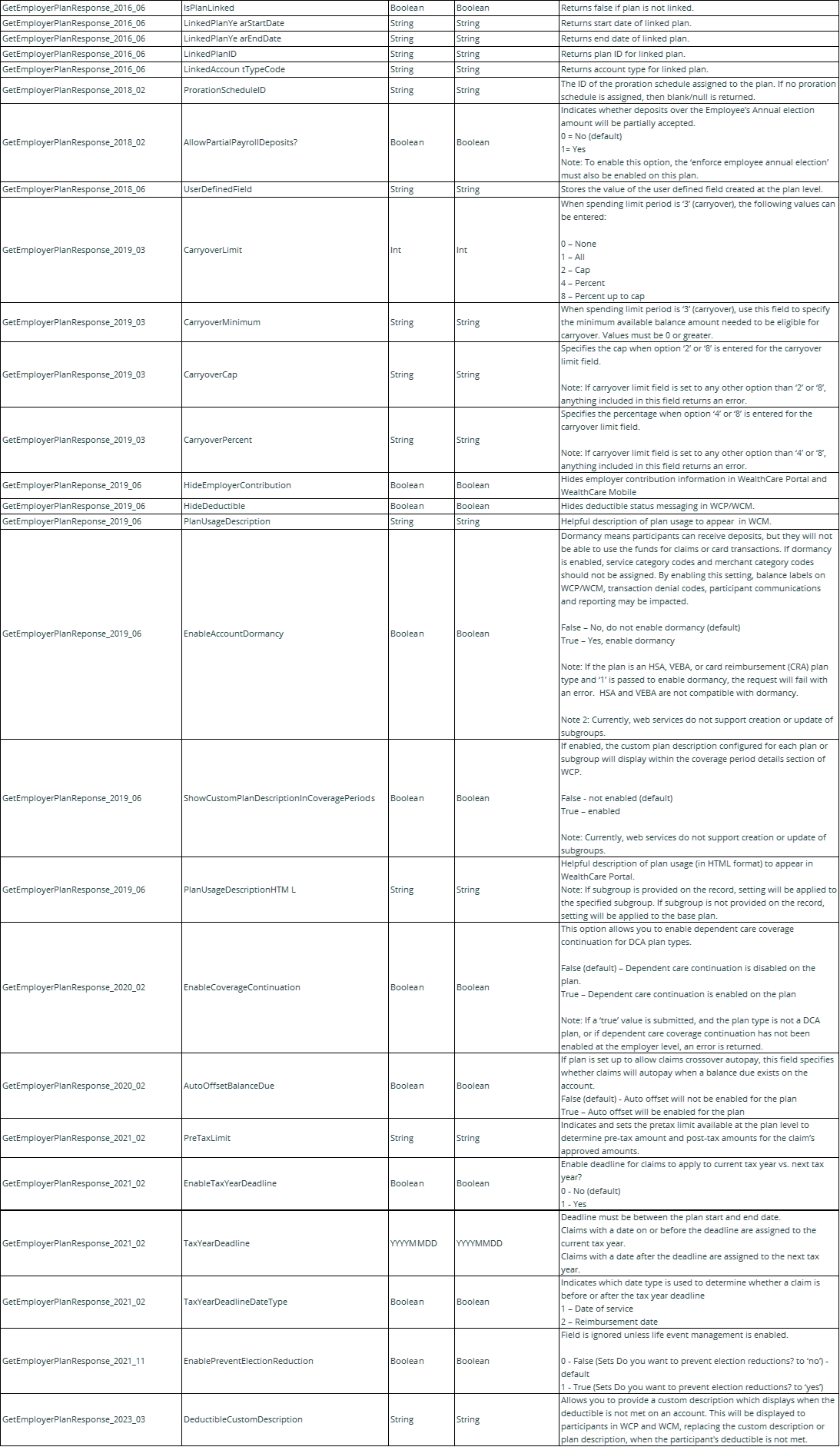
Example of a GetEmployerPlan SOAP request message
<?xml version="1.0" encoding="utf-8" ?>
<soap:Envelope xmlns:soap="http://schemas.xmlsoap.org/soap/envelope/" xmlns:xsi="http://www.w3.org/2001/XMLSchema-instance" xmlns:xsd="http://www.w3.org/2001/XMLSchema">
<soap:Header>
<MBISessionHeader xmlns="http://www.medibank.com/MBIWebServices/SoapHeader/">
<MBISessionID>kkhhjnze5fuaxz45fkwama55</MBISessionID>
</MBISessionHeader>
</soap:Header>
<soap:Body>
<GetEmployerPlan xmlns="http://www.medibank.com/MBIWebServices/Employer/Messages/EmployerPlan/Request/2004/06/">
<getEmployerPlanRequest>
<TpaId>T00202</TpaId>
<EmployerId>CYNCYN</EmployerId>
<PlanId>CYNP1</PlanId>
<AccountTypeCode>ACO</AccountTypeCode>
<PlanYearStartDate>2004-01-01</PlanYearStartDate>
<PlanYearEndDate>2004-12-31</PlanYearEndDate>
</getEmployerPlanRequest>
</GetEmployerPlan>
</soap:Body>
</soap:Envelope>
Example of a GetEmployerPlan SOAP response message
<?xml version="1.0" encoding="utf-8" ?>
<soap:Envelope xmlns:soap="http://schemas.xmlsoap.org/soap/envelope/"
xmlns:xsi="http://www.w3.org/2001/XMLSchema-instance"
xmlns:xsd="http://www.w3.org/2001/XMLSchema">
<soap:Header>
<MBIMessageIdHeader xmlns="http://www.medibank.com/MBIWebServices/SoapHeader/" />
</soap:Header>
<soap:Body>
<GetEmployerPlanResponse_2006_05 xmlns="http://www.medibank.com/MBIWebServices/Employer/Messages/EmployerPlan/Response/2006/05/">
<GetEmployerPlanResult>
<TpaId>T00202</TpaId>
<EmployerId>CYNCYN</EmployerId>
<PlanId>CYNP1</PlanId>
<AccountTypeCode>ACO</AccountTypeCode>
<PlanYearStartDate>20040101</PlanYearStartDate>
<PlanYearEndDate>20041231</PlanYearEndDate>
<GracePeriodEndDate>20041231</GracePeriodEndDate>
<SpendingLimitPeriod xmlns="http://www.medibank.com/MBIWebServices/Enums/">None</SpendingLimitPeriod>
<SpendingDepositAmount>-1.0000</SpendingDepositAmount>
<SpendingTransactionAmount>-1.0000</SpendingTransactionAmount>
<AllowPartialManualTransaction>false</AllowPartialManualTransaction>
<AutoDepositBypass>false</AutoDepositBypass>
<PayCycleTypeCode xmlns="http://www.medibank.com/MBIWebServices/Enums/">NoAutoDeposit</PayCycleTypeCode>
<ConvenienceFeePayor xmlns="http://www.medibank.com/MBIWebServices/Enums/">None</ConvenienceFeePayor>
<ConvenienceFeeAmount>0</ConvenienceFeeAmount>
<MaxTransactionAmount>100.0000</MaxTransactionAmount>
<MaxTotalAmount>100.0000</MaxTotalAmount>
<DefaultPlanOptions xmlns="http://www.medibank.com/MBIWebServices/Enums/">None</DefaultPlanOptions>
</GetEmployerPlanResult>
</GetEmployerPlanResponse>
</soap:Body>
</soap:Envelope>
Example Client Code
The following is an example of the client code (using a .NET proxy class for accessing the service) used when calling the GetEmployerPlan web method.
try
{
_dataset.Tables["EmployerPlan"].Clear();
// Create the session SOAP header in order to pass the Service
// the client’s current session id.
mbiSessionHeader = new EmployerPlanServiceNameSpace.MBISessionHeader();
// Create proxy object for the service
proxy = new EmployerPlanServiceNameSpace.EmployerPlanService();
// Create request message for method call (input parameters)
request = new EmployerPlanServiceNameSpace.GetEmployerPlanRequest ();
// Set the input parameters
request.AccountTypeCode = _AccountTypeCode.Text;
request.EmployerId = _EmployerId.Text;
request.PlanId = _PlanId.Text;
if(_PlanYearEndDate.Text.Length > 0)
{
request.PlanYearEndDate = Convert.ToDateTime(_PlanYearEndDate.Text);
}
if(_PlanYearStartDate.Text.Length > 0)
{
request.PlanYearStartDate = Convert.ToDateTime(_PlanYearStartDate.Text);
}
request.TpaId = _TpaId.Text;
// session ID returned from logon method
mbiSessionHeader.MBISessionID = _sessionId.Text;
proxy.MBISessionHeaderValue = mbiSessionHeader;
// Call the method
response = proxy.GetEmployerPlan(request);
}
catch(SoapException se)
{
MessageBox.Show(Formatter.FormatSoapException(se));
}
catch(Exception ex)
{
MessageBox.Show("EXCEPTION:" + ex.Message);
}
GetEmployerPlans
This method is used to retrieve all the employer’s plans.
History
The GetEmployerPlans methods are listed below:
Request Messages
GetEmployerPlans_2023_03
GetEmployerPlans_2020_02
GetEmployerPlans_2019_10
GetEmployerPlans_2019_06
GetEmployerPlans_2011_04
GetEmployerPlans_2010_04
GetEmployerPlans_2007_12
GetEmployerPlansRequest
Response Messages
GetEmployerPlansResponse_2023_03
GetEmployerPlansResponse_2020_11
GetEmployerPlansResponse_2020_02
GetEmployerPlansResponse_2019_10
GetEmployerPlansResponse_2019_06
GetEmployerPlansResponse_2012_06
GetEmployerPlansResponse_2011_04
GetEmployerPlansResponse_2010_04
GetEmployerPlansResponse_2009_04
GetEmployerPlansResponse_2008_07
GetEmployerPlansResponse_2007_12
GetEmployerPlansResponse_2006_05
GetEmployerPlansResponse
GetEmployerPlans Request/Response Messages
The GetEmployerPlans method requires the following request and response messages (input and output data).
The table below includes the following request messages:
GetEmployerPlansRequest

The table below includes the following request messages:
GetEmployerPlansResponse_2023_03
GetEmployerPlansResponse_2020_11
GetEmployerPlansResponse_2021_02
GetEmployerPlansResponse_2020_02
GetEmployerPlansResponse_2019_10
GetEmployerPlansResponse_2019_06
GetEmployerPlansResponse_2019_03
GetEmployerPlansResponse_2018_06
GetEmployerPlansResponse_2018_02
GetEmployerPlansResponse_2016_06
GetEmployerPlansResponse_2013_06
GetEmployerPlansResponse_2012_06
GetEmployerPlansResponse_2011_04
GetEmployerPlansResponse_2010_04
GetEmployerPlansResponse_2009_04
GetEmployerPlansResponse_2008_07
GetEmployerPlansResponse_2007_12
GetEmployerPlansResponse_2006_05
GetEmployerPlansResponse


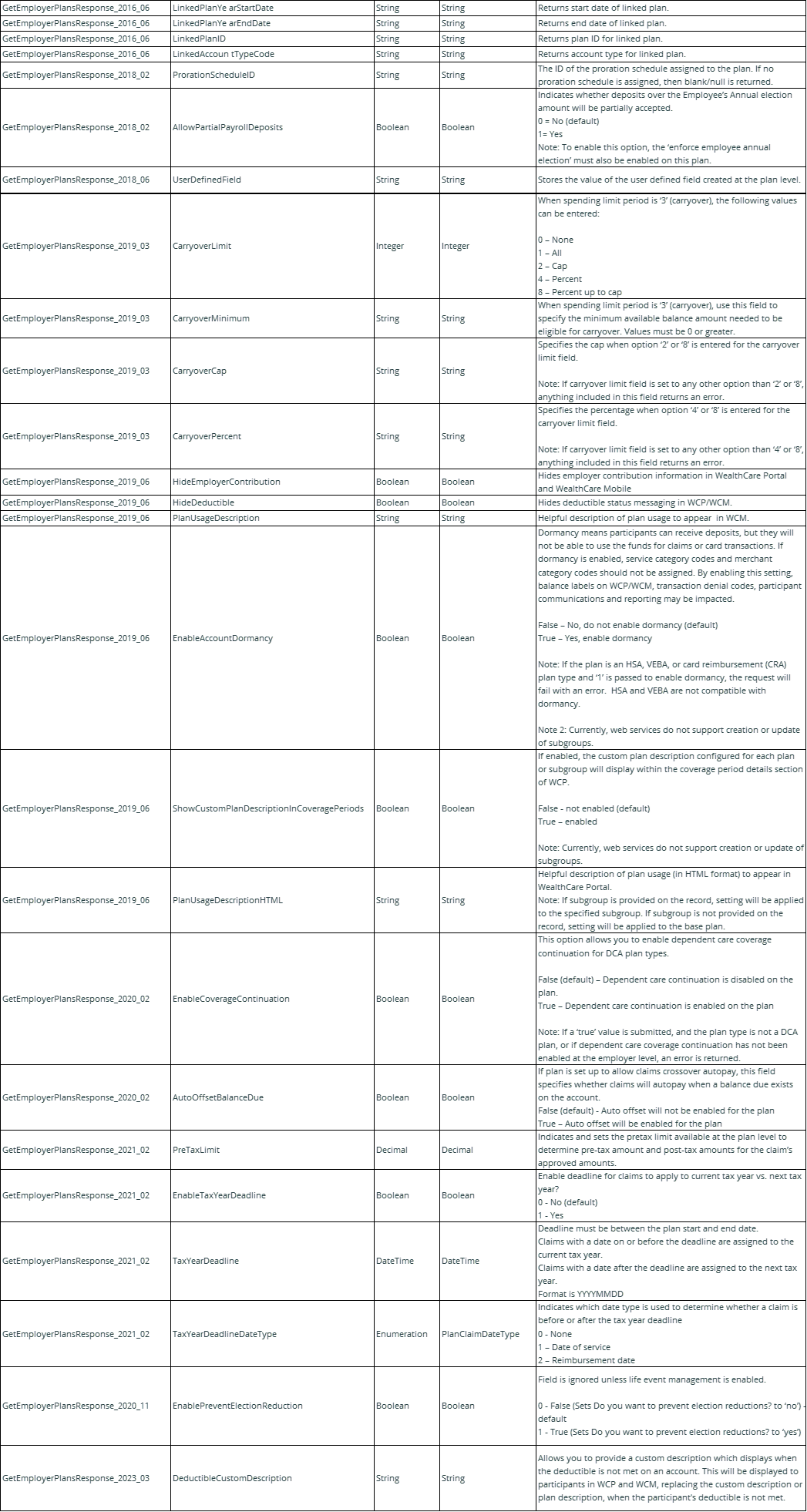
Example of a GetEmployerPlans SOAP request message
<?xml version="1.0" encoding="utf-8" ?>
<soap:Envelope xmlns:soap="http://schemas.xmlsoap.org/soap/envelope/" xmlns:xsi="http://www.w3.org/2001/XMLSchema-instance" xmlns:xsd="http://www.w3.org/2001/XMLSchema">
<soap:Header>
<MBISessionHeader xmlns="http://www.medibank.com/MBIWebServices/SoapHeader/">
<MBISessionID>alcfwq55w34yl555c4vxlyv4</MBISessionID>
</MBISessionHeader>
</soap:Header>
<soap:Body>
<GetEmployerPlans xmlns="http://www.medibank.com/MBIWebServices/Employer/Messages/EmployerPlan/Request/2004/06/">
<getEmployerPlansRequest>
<TpaId>T00238</TpaId>
<EmployerId>CYNCYN</EmployerId>
</getEmployerPlansRequest>
</GetEmployerPlans>
</soap:Body>
</soap:Envelope>
Example of a GetEmployerPlans SOAP response message
<?xml version="1.0" encoding="utf-8" ?>
<soap:Envelope xmlns:soap="http://schemas.xmlsoap.org/soap/envelope/" xmlns:xsi="http://www.w3.org/2001/XMLSchema-instance" xmlns:xsd="http://www.w3.org/2001/XMLSchema">
<soap:Header>
<MBIMessageIdHeader xmlns="http://www.medibank.com/MBIWebServices/SoapHeader/" />
</soap:Header>
<soap:Body>
<GetEmployerPlansResponse_2006_05 xmlns="http://www.medibank.com/MBIWebServices/Employer/Messages/EmployerPlan/Response/2006/05/">
<GetEmployerPlansResult>
<GetEmployerPlansResponse_2006_05>
<TpaId>T00238</TpaId>
<EmployerId>CYNCYN</EmployerId>
<PlanId>CYN</PlanId>
<AccountTypeCode>ACO</AccountTypeCode>
<PlanYearStartDate>20031006</PlanYearStartDate>
<PlanYearEndDate>20051118</PlanYearEndDate>
<SpendingLimitPeriod xmlns="http://www.medibank.com/MBIWebServices/Enums/">None</SpendingLimitPeriod>
<SpendingDepositAmount>-1.0000</SpendingDepositAmount>
<SpendingTransactionAmount>-1.0000</SpendingTransactionAmount> <AllowPartialManualTransaction>false</AllowPartialManualTransaction>
<AutoDepositBypass>false</AutoDepositBypass>
<PayCycleTypeCode xmlns="http://www.medibank.com/MBIWebServices/Enums/">Monthly</PayCycleTypeCode>
<ConvenienceFeePayor xmlns="http://www.medibank.com/MBIWebServices/Enums/">None</ConvenienceFeePayor>
<ConvenienceFeeAmount>0</ConvenienceFeeAmount>
<MaxTransactionAmount>1000.0000</MaxTransactionAmount>
<MaxTotalAmount>1000.0000</MaxTotalAmount>
<DefaultPlanOptions>false</DefaultPlanOptions>
</GetEmployerPlansResponse_2006_05>
</GetEmployerPlansResult>
</GetEmployerPlansResponse>
</soap:Body>
</soap:Envelope>
Example Client Code
The following is an example of the client code (using a .NET proxy class for accessing the service) used when retrieving a list of employer’s plans using the GetEmployerPlans web method.
try
{
_dataset.Tables[0].Clear();
// Create proxy object for the service
proxy = new WebServiceTestHarness.EmployerPlanServiceNameSpace.EmployerPlanService();
// Create request message for method call (input parameters)
request = new WebServiceTestHarness.EmployerPlanServiceNameSpace.GetEmployerPlansRequest ();
// Create the session SOAP header in order to pass the Service
// the client’s current session id.
mbiSessionHeader = new WebServiceTestHarness.EmployerPlanServiceNameSpace.MBISessionHeader();
mbiSessionHeader.MBISessionID = _sessionId;
proxy.MBISessionHeaderValue = mbiSessionHeader;
request.EmployerId = _EmployerId.Text;
request.PlanYear = (EmployerPlanServiceNameSpace.PlanYear) Enum.Parse(typeof(EmployerPlanServiceNameSpace.PlanYear),_PlanYear.Text,true);
request.TpaId = _TpaId.Text;
response = proxy.GetEmployerPlans(request);
}
catch(SoapException se)
{
MessageBox.Show(Formatter.FormatSoapException(se));
}
catch(Exception ex)
{
MessageBox.Show("EXCEPTION:" + ex.Message);
}
SetPlanPriority
This method is used to set plan priority for all plans associated with an employer
History
The SetPlanPriority methods are listed below:
Request Messages
SetPlanPriorityRequest
Response Messages
SetPlanPriorityResponse
SetPlanPriority Request/Response Messages
The SetPlanPriority method requires the following request and response messages (input and output data).
The table below includes the following request messages:
SetPlanPriorityRequest

Each PlanPrioritiesGen requires the following fields:
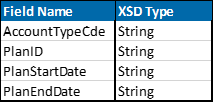
Response Message: Request submitted successfully.
GetPlanPriority
This method is used to get a list of plans in priority order for all plans associated with an employer
History
The GetPlanPriority methods are listed below:
Request Messages
GetPlanPriorityRequest
Response Messages
GetPlanPriorityResponse
GetPlanPriority Request/Response Messages
The GetPlanPriority method requires the following request and response messages (input and output data).
The table below includes the following request messages:
GetPlanPriorityRequest

GetPlanPriorityResponse

Copyright © 2023 Alegeus Technologies, LLC. All rights reserved. Alegeus, Alegeus Technologies, WealthCare, WealthCare Saver are registered trademarks of Alegeus Technologies, LLC